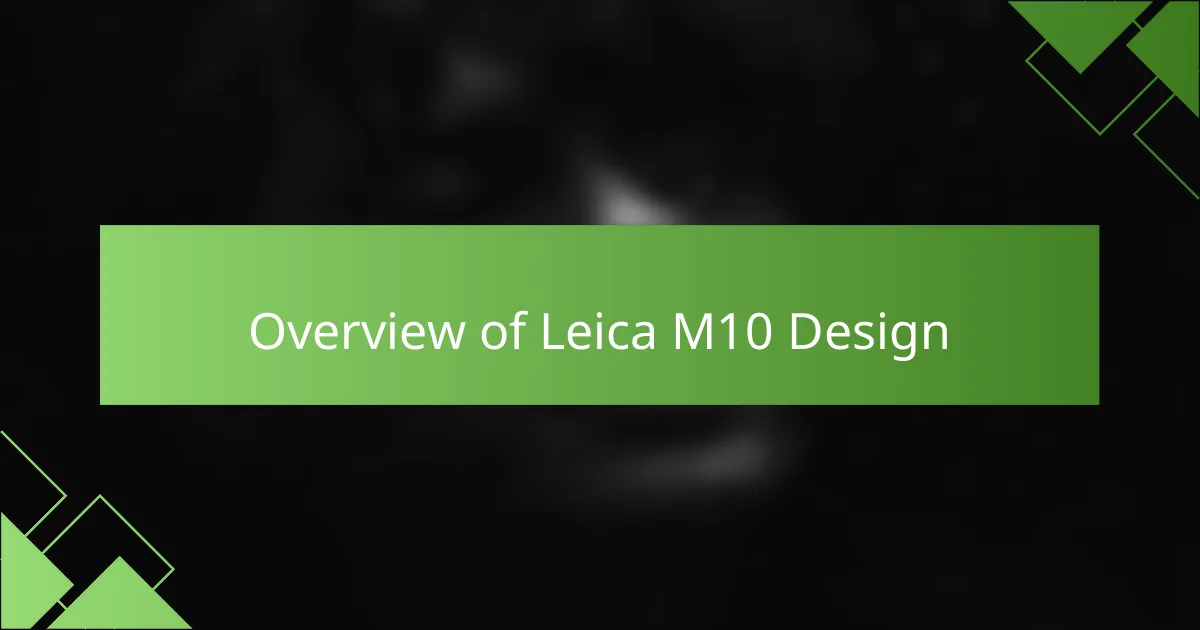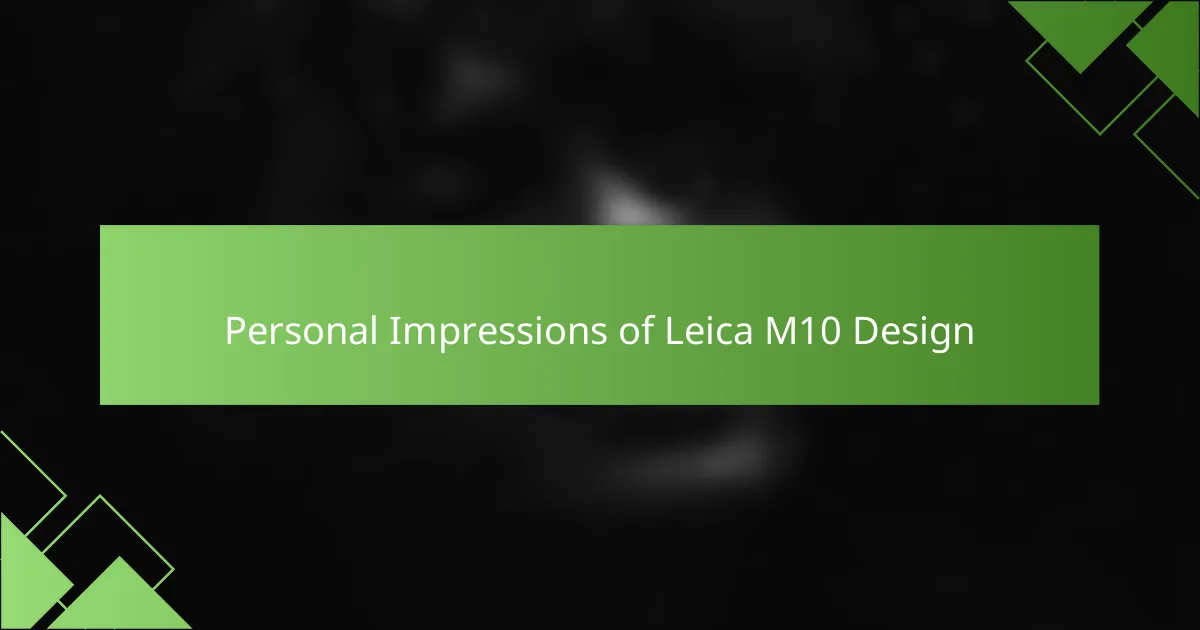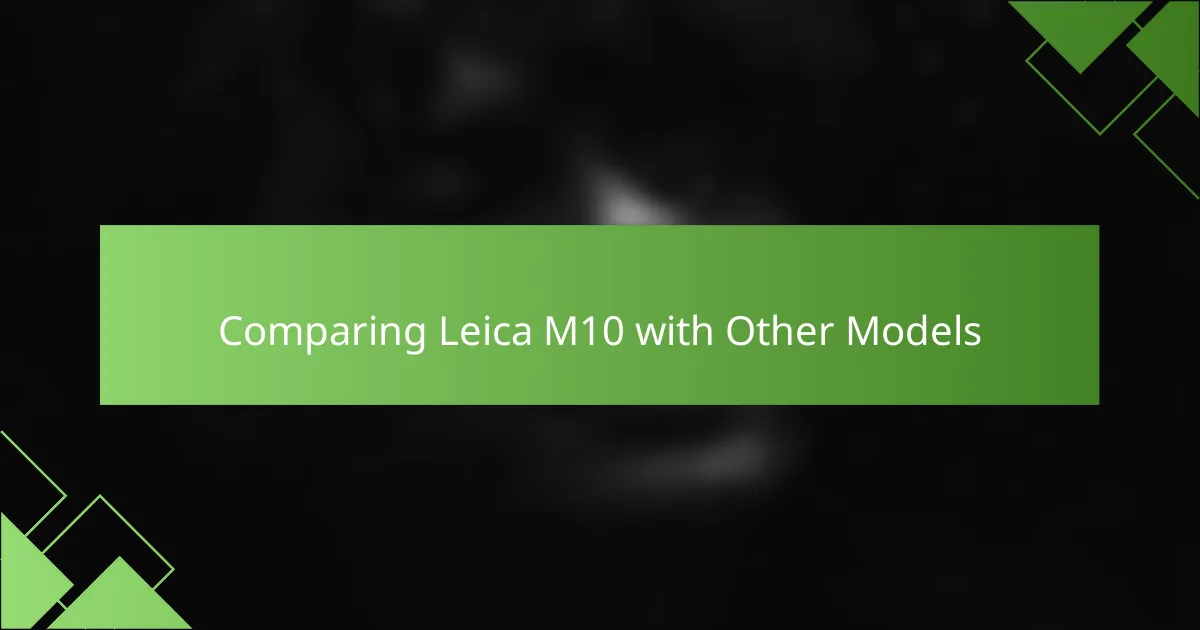Key takeaways
- The Leica M10 combines classic design with modern functionality, enhancing the tactile experience for photographers.
- Its minimalist controls and solid construction promote intuitive handling, encouraging a more deliberate approach to photography.
- Key features include a 24 MP full-frame sensor, a compact size, and a unique optical rangefinder system that fosters a deeper connection with the subject.
- In comparisons with other models, the M10 stands out for its simplicity, manual controls, and emphasis on a thoughtful photography experience.

Overview of Leica M10 Design
The design of the Leica M10 really speaks to me as a photographer who values both form and function. It combines classic elegance with modern engineering, making it a joy to handle. The minimalist controls and solid construction create a tactile experience that enhances my photography. It feels durable yet refined, which is something I appreciate in a camera.
In my experience, the rangefinder system is not just about tradition; it encourages a more deliberate approach to capturing images. With the M10, there’s a certain satisfaction in composing shots manually, a feeling that digital cameras often overlook. Each aspect of the design—the compact body, the textured leatherette finish—adds to its charm, making photography feel like a special occasion every time I pick it up.
Here’s a comparison of some key design features of the Leica M10:
| Feature | Leica M10 |
|---|---|
| Body Material | Magnesium Alloy |
| Weight | 660g (1.46 lbs) |
| Dimensions | 139 x 80 x 38 mm |
| Viewfinder Type | Optical Rangefinder |
| ISO Range | 100-50,000 |
| Battery Life | 210 Shots |

Importance of Camera Design in Photography
The design of a camera is more than just aesthetics; it plays a crucial role in the photographer’s experience. When I first held a Leica M10, the feel and layout instantly affected how I approached my photography. Ergonomics, weight, and button placement can either enhance your creativity or hinder it; I’ve found that a well-designed camera can inspire confidence and lead to more spontaneous shots.
For instance, the simplicity of the M10’s design allows for intuitive handling, which I cherish while on the go. Often, I find myself responding to fleeting moments, and having a camera that feels just right in my hands is essential to capturing those memories.
| Feature | Leica M10 |
|——————-|——————–|
| Weight | Lightweight |
| Ergonomics | Excellent handling |
| Build Quality | Premium materials |
| Control Layout | Intuitive design |
| Aesthetic Appeal | Classic yet modern |

Key Features of Leica M10
The Leica M10 stands out with its classic rangefinder design, seamlessly blending technological innovation with timeless aesthetics. In my experience, the tactile feel of the camera is exceptional, making it a joy to handle. The minimalist interface and elegant simplicity inspire creativity by allowing photographers to focus solely on their subjects.
The M10’s full-frame sensor offers stunning image quality, and I’ve often found that the colors it captures are rich and vibrant. One feature that really resonates with me is the discreet shooting mode, which allows for candid photography without drawing attention. Personally, this has led to some of my most cherished candid shots.
Here’s a comparison table highlighting the key features of the Leica M10:
| Feature | Details |
|---|---|
| Sensor | 24 MP Full-Frame |
| ISO Range | 100 to 50,000 |
| Screen | 3.0″ LCD, 1.040.000 Pixels |
| Viewfinder | Optical Rangefinder |
| Weight | 660 g |

Impact of Design on Photography Experience
The design of the Leica M10 significantly enhances the photography experience. I find that its minimalistic yet robust aesthetics encourage a sense of authenticity and connection with the subject. Holding the camera feels like an extension of myself, and that tactile experience often inspires me to capture moments that resonate deeply.
Moreover, the thoughtful layout of the controls is intuitive, allowing me to adjust settings quickly without taking my eye off the scene. The balance of weight and form gives me confidence, whether I’m shooting in bustling city streets or quiet natural settings. This design philosophy not only elevates the act of photographing but also deepens my engagement with the art form itself.
In comparison to other camera designs, the M10 truly stands out. While some brands focus on flashy features, I appreciate how Leica prioritizes a seamless interaction between the photographer and the craft. This commitment to design principles ultimately transforms the photography experience.
| Camera Model | Design Features |
|---|---|
| Leica M10 | Minimalistic, intuitive controls, solid build |
| Canon EOS R6 | Modern, versatile touch screen, lightweight |
| Nikon Z6 II | Ergonomic, dual control dials, robust |

Personal Impressions of Leica M10 Design
The design of the Leica M10 captivates me. Its sleek, minimalist aesthetic feels like a nod to timeless elegance while maintaining the functionality that photographers crave. I vividly remember my first encounter with the M10; holding it was like cradling a piece of art. The solid build and intuitive controls instantly made me feel connected to my craft.
What strikes me most is the way the design encourages thoughtful photography. Every curve and angle is not just for looks; it enhances the photographer’s experience. Here are a few aspects that stand out:
- Classic Aesthetics: The retro design exudes sophistication and has a classic black or silver finish that never goes out of style.
- Manual Controls: The tactile feel of the dials provides a satisfying interaction, reminding me to slow down and think about each shot.
- Compact Size: Its lightweight and compact form make it an ideal companion for street photography, allowing for easy maneuverability.
- Optical Beauty: The rangefinder system accentuates the connection between the photographer and the subject, creating a more immersive shooting experience.
These elements make the Leica M10 not just a camera but a compelling tool that enhances the photographer’s journey.

Comparing Leica M10 with Other Models
The Leica M10 undeniably holds its own against other models by emphasizing a blend of simplicity and quality. For example, when I compare it to the Canon EOS R6, I notice a distinct difference in handling. While the R6 features a touchscreen and weighs a bit less, I find myself gravitating toward the M10 for its tactile experience and mechanical focus. There’s something satisfying about the manual controls that the R6’s electronic interface can’t fully replicate.
In contrast, when I think about the Nikon Z6 II, the ergonomic design boasts dual control dials, making it quick to adjust settings. However, I often feel that this complexity detracts from the core essence of photography. The M10 keeps me grounded, urging me to engage more deeply with each shot rather than relying on automatic settings. Does it make me more deliberate as a photographer? Absolutely.
Even among competitors in today’s market, the Leica M10 stands out for its iconic optical rangefinder system. This feature requires a different approach to composition, which I appreciate, especially in candid scenarios. The process of finding the perfect frame through the M10’s viewfinder, rather than relying solely on a digital screen, feels more intimate and connected. In a world filled with bells and whistles, sometimes, less truly is more.